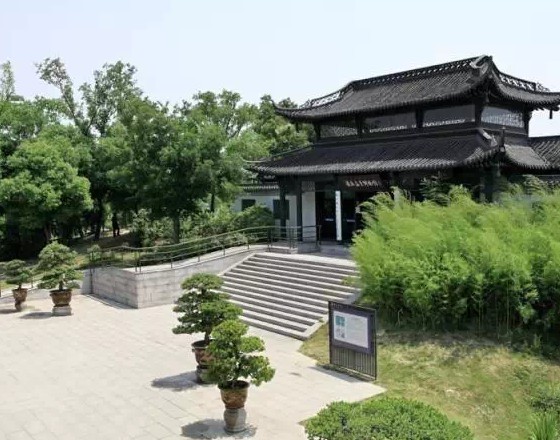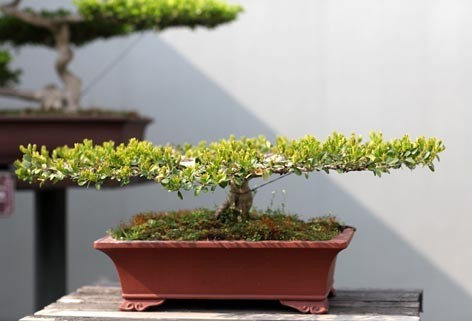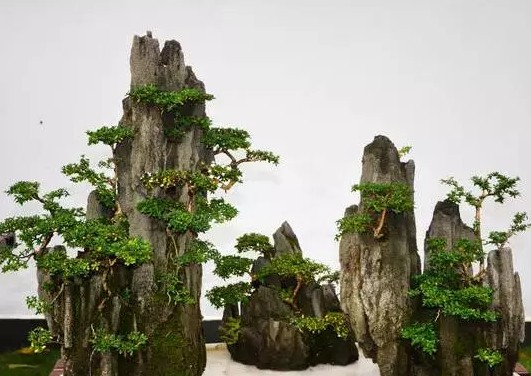Yangpai bonsai museum bonsai garden
Yangpai Bonsai Museum is located in the thin West Lake Scenic area, which integrates collection, display, popularization, research and other functions, covering an area of more than 40 mu.
Yangpai bonsai is one of the five major schools in China, and its one-inch (one-inch 82.5px) three-bend production skills can be described as unique in the world. In order to better protect this set of special bonsai production skills, Yangzhou Bonsai Museum has recently declared to the relevant departments the national intangible cultural heritage, which has been accepted. Yangpai bonsai has a long history, its distinct, neat and stable unique shape, the key lies in the exquisite cutting skills.
It is understood that Yangpai bonsai has repeatedly won gold and silver in the National Bonsai Grand Prix with this rigorous production skill. In the early 1980s, it was identified as one of the five major bonsai schools in the country.
One inch and three bends are based on the Chinese painting theory of "branches without inch straight". Each branch in the cloud is tied into a fine serpentine bend, with up to three bends per inch, while the leaves remain parallel, just like a piece of clouds. therefore, it is called "one inch, three bends". This is the most unique thing about Yangpai bonsai. Can you reach it from the following bonsai?

Yangpai Bonsai Museum is located in the thin West Lake Garden, surrounded by streams, curved bridges, pavilions, long corridors, verdant flowers and trees at 04:00, is a collection, display, popularization, research and other functions as one of the bonsai museum.
The existing collection covers an area of more than 40 mu, with a construction area of more than 3200 square meters and an outdoor landscape wall of more than 300m. The museum is divided into three parts: indoor exhibition area, outdoor exhibition area and bonsai production and conservation area, with demonstration hall, master studio, Yangzhou bonsai research institute and so on.
Indoor exhibition hall
Bonsai has a long history and originated in China. Chinese bonsai originated in the Han and Jin dynasties, formed in the Tang Dynasty, developed in the Song and Yuan dynasties, flourished in the Ming and Qing dynasties, declined in modern times, and is now revived. Yangzhou bonsai, which is almost in step with Chinese bonsai, is the pioneer and important part of Chinese bonsai.
Outdoor exhibition hall
The bonsai art style of Yang School was formed in the Ming Dynasty, matured in the Qing Dynasty, and enjoyed a good reputation in the contemporary era. It benefits from Yangzhou culture and integrates itself into Yangzhou culture. It integrates "poetry, calligraphy, painting and technology" into a unique elegant art, which can be called the masterpiece of Chinese bonsai art.
Huang Shen, one of the eight eccentrics of Yangzhou, "bonsai"
Yangpai bonsai and Yangzhou gardens come down in a continuous line and have many common personalities. They are both based on nature and higher than nature. They are the taste of poetry and painting and the implication of artistic conception.
There is a close relationship between Yangzhou School of Bonsai and Yangzhou School of painting, and the two learn from each other. The calligraphy and painting theory and bonsai paintings of Yangzhou eight eccentrics provide aesthetic reference for Yang to send bonsai.
Yangpai bonsai is a combination of art and technology, skill and culture. Its works embody the author's aesthetic taste and life perception, and record the social style of a certain period.
The work "small bridge and flowing water's Family"
On the basis of inheriting the tradition, the contemporary Yangpai bonsai shows a trend of diversified development. Many traditional bonsai masterpieces and innovative bonsai works have won important awards in international and domestic top exhibitions.
"the Rhyme of the late Ming Dynasty" by Yangpai Bonsai Museum
It integrates the profound cultural accumulation of Yangzhou into the miniature bonsai, which embodies the beauty of art, culture and inheritance. A classic couplet describes Yangpai bonsai in this way: "with less wins more, Yao Cao Qi flowers glory four seasons; that is, the small view is big, the abbot Peng Lai sees a spot."
Time: 2019-06-04 Click:
- Prev

Protection of Yangpai Bonsai works
Yangzhou Yangpai Bonsai Museum has a number of ancient bonsai works. They are living cultural relics, and although they have gone through hundreds of years of changes, they still maintain their original vibrant form, which is also inseparable from the use of Yangpai bonsai technology for conservation, management and re-creation.
- Next

Sichuan style bonsai art style
Sichuan bonsai, also known as Jiannan bonsai, is an excellent traditional art of the Han nationality and a treasure of garden art. It is a bonsai art school named after Sichuan Province, and it is also one of the five major schools of bonsai in China. Among them, it is divided into two local styles of western Sichuan and eastern Sichuan, which is famous for its simplicity and preciseness and Qiu qu.
Related
- Fuxing push coffee new agricultural production and marketing class: lack of small-scale processing plants
- Jujube rice field leisure farm deep ploughing Yilan for five years to create a space for organic food and play
- Nongyu Farm-A trial of organic papaya for brave women with advanced technology
- Four points for attention in the prevention and control of diseases and insect pests of edible fungi
- How to add nutrient solution to Edible Fungi
- Is there any good way to control edible fungus mites?
- Open Inoculation Technology of Edible Fungi
- Is there any clever way to use fertilizer for edible fungus in winter?
- What agents are used to kill the pathogens of edible fungi in the mushroom shed?
- Rapid drying of Edible Fungi

